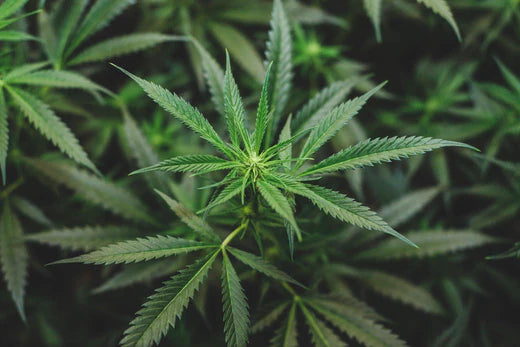Bhanga is an old medicinal plant also known as marijuana, Indian hemp, and ganja. The botanical name of the plant is Cannabis Sativa. It is a member of the family Cannabaceae. Bhanga is a well-known annual plant with an upright stem that can reach heights of three to ten feet or more, is slightly branched, and has hair that is greyish-green in color. The plant's leaves are palmate, stipulate, alternately arranged, long petiole, smooth and dark green with serrations, singularly present, lanceolate, and 3 to 11 acuminate leaflets in number. These measure up to 10 cm in length and 1.5 cm in width. Leaflets feature tapered, sharp stipules near the base. These have opposing basal leaves as well. Vegetative leaves are the name for these basal leaves. The bhanga plant produces tiny, unisexual flowers. The ovary is enclosed in a sheath by a five-veined leaf on the female flower. These have one gland and are hairy and single. The flower's ovary has one cell, a dangling ovule, and tread-like stigmas. Their stigma stretches out of the flower nearly as much as their length, and their ovaries are quite smooth. The male one is downy and pale yellow in color, with five segments that are practically present independently. The bhanga fruit is tiny and entirely comprised of seeds. It has a grayish-brown tint.
General Description
The bhanga plant, grown for its fibers, food, and medicine, has a connection to rituals from ancient times. The substance has a history dating back to the Vedic era and is well-known in the medical sector under the name Vijaya. Around 1000 BC, bhang was utilized as an intoxicant in India. In Hindu culture, it is fundamental. It is mentioned as a useful herb that reduces anxiety in the Artharvavedic scriptures. Bhang was a revered Lord Shiva figure. When the Maha Shivratri festival is celebrated, it is served as a prasad.
Bhang is used as the Prasad during the Maha Shivaratri festival by those who worship Lord Shiva. On this day, the followers of Lord Shiva create a mixture of the plants Bhang Leaf, Milk, Almond, Guava Leaf, and other herbs. One of the most well-known and frequently served dishes during Maha Shivratri is the bhang pakora.
The scientific term for marijuana, Cannabis Sativa, comes from the Latin word sativa, which means to sow or cultivate. This herb possesses qualities that are aphrodisiac, diuretic, anodyne, narcotic, neuralgic, anti-rheumatism, digestive, astringent, and antispasmodic. It is useful for treating a variety of conditions, including chronic cystitis, gonorrhea, gout, infantile convulsions, sleeplessness, and more. Additionally, it is renowned for providing relief from severe pain, swelling, wounds, and dandruff.
Bhanga is incredibly rich in phytochemicals. This has more than 60 cannabinoids and 140 different terpenes. Cannabine, cannabinone, cannabiol, canabidiolic acid, cannabielsoin, cannabichromene, tetrahydrocannabinol, cannabicyclol, cannabigerol, and other cannabinoids are the primary components of this plant. These are located in the plant's roots. Terpenes are found in plant parts' essential oils. Lignanamides and phenolic amides are found in fruits and roots.
Classification
Habitat
It is native of central Asia. It is grown in China, Pakistan, Iran, Iraq, China, Europe, and Asia. 900 BC saw the beginning of bhanga cultivation in India. Later, in the Middle Ages, it was introduced to North Africa. The cultivation of this plant is restricted to a few locations in India. In parts of northwestern India including Rajasthan, Kerala, Tamil Nadu, and Bihar, it is wild. Nainital, Garhwal, Uttar Pradesh, Almora, and Amritsar are among these regions. Although to a lesser extent, it is also grown in Kashmir, Taravancore, and Nepal.
Other Names
Ayurvedic Properties
|
Particular |
Hindi / Sanskrit |
English |
|
Rasa (Taste) |
Tikta |
Bitter |
|
Guna (Physical Property) |
Laghu, Vyavayi, Tikshna |
Light, spread across the body without being processed first, Sharp |
|
Virya (Potency) |
Ushna |
Hot |
|
Vipaka (Post-Digestive Taste) |
Katu |
Pungent |
Effects On Doshas
This aids in balancing the kapha and vata doshas. It aids in boosting pitta dosha.
Classical Categorization
The Charak Samhita, Vagbhata, and Sushrut Samhita do not include an accurate reference. Plant references date back to the Nighantu era.
- This herb was made known by Chakradatta in the Kustha Chikitsa, and he noted that it had the ability to eliminate external pathogens.
- In the chapter of Atisaradhikara, Bhavaprakasha discussed the bhanga's medicinal properties.
- Raja Nighantu outlined the medication's medicinal applications.
- There is a description of Bhanga's therapeutic uses in the Nasadhikara.
- The word "bhanga" appears in the Shodala nighantu.
Practical Uses
- Bhanga is believed to have nerve-stimulating properties, therefore it can aid with convulsions, delirium, neuralgia, recurrent headaches, nervous vomiting, and migraine.
- Bhanga is consumed as an appetizer and provides relief from dyspepsia and intestinal issues.
- The plant's leaves are used to treat the insomnia issue.
- Their leaves are also used to treat wounds, sores, tumors, skin conditions, and itching issues.
- It is highly helpful in providing relief from dandruff and head lice.
- In cases of diarrhea, plies, and dysentery, bhanga is highly helpful.
- In cases of inflammation and hemorrhoids, this is used.
- It is well known for having aphrodisiac qualities.
- It is extremely helpful for eye conditions like photophobia.
- Malaria, black water fever, and blood poisoning are all treated with it.
Parts Used
- Leaves
- Seeds
- Resins (Charas)
- Flowers (Ganja)
Dosage
- Leaf powder – 125 to 250 mg
- Ganja – 50 to 125 mg
- Charas – 30 mg
Precautions to be taken
- During pregnancy and nursing, it is dangerous.
- You shouldn't take it if your blood pressure is high.
- It shouldn't be taken for an extended period of time or in excessive doses because it lowers immunity, increases anxiety, decreases testosterone, and affects the quantity and quality of sperm.

